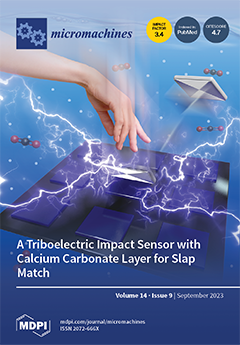Driven by the loss of bone calcium, the elderly are prone to osteoporosis, and regular routine checks on bone status are necessary, which mainly rely on bone testing equipment. Therefore, wearable real-time healthcare devices have become a research hotspot. Herein, we designed a
[...] Read more.
Driven by the loss of bone calcium, the elderly are prone to osteoporosis, and regular routine checks on bone status are necessary, which mainly rely on bone testing equipment. Therefore, wearable real-time healthcare devices have become a research hotspot. Herein, we designed a high-performance flexible ultrasonic bone testing system using axial transmission technology based on quantitative ultrasound theory. First, a new rare-earth-element-doped PMN-PZT piezoelectric ceramic was synthesized using a solid-state reaction, and characterized by X-ray diffraction and SEM. Both a high piezoelectric coefficient
d33 = 525 pC/N and electromechanical coupling factors of
k33 = 0.77,
kt = 0.58 and
kp = 0.63 were achieved in 1%La/Sm-doped 0.17 PMN-0.47 PZ-0.36 PT ceramics. Combining a flexible PDMS substrate with an ultrasonic array, a flexible hardware circuit was designed which includes a pulse excitation module, ultrasound array module, amplification module, filter module, digital-to-analog conversion module and wireless transmission module, showing high power transfer efficiency and power intensity with values of 35% and 55.4 mW/cm
2, respectively. Finally, the humerus, femur and fibula were examined by the flexible device attached to the skin, and the bone condition was displayed in real time on the mobile client, which indicates the potential clinical application of this device in the field of wearable healthcare.
Full article






